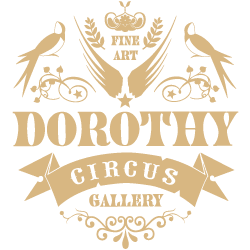On the 14th of April 2012 Dorothy Circus Gallery opens its doors to the long awaited exhibition of Leyla Ataya, Russian-born and New Zealand based artist, who is already a name among the big ones on the international new surrealist scenery. As in the Flemish portraits of Jan Vermeer, the beauty of Leila Ataya’s woman is transformed by the enchantment that it arouses and becomes a representation of the mystery of creation. This story starts in the Garden of Eden, the fantastic place where everything begins.
The Woman is born, Eve is her first name, and even though we don’t know anything about her features, her curious look, which has immortalized her youth and lives like a ghost through time, remains indelible. We find her as a sumptuously dressed redhead queen, with icy eyes that reveal a subtle wickedness, holding a mysterious chalice with precious butterflies coming out of it.
The same face, adorned with a fantastic and rich turban, seduces us with the sweet patience of an Eastern concubine that envelops in the night all her unrevealed passions. We follow her steps walking through the late Liberty age, her pale skin caressed by a fox with eyes as glassy as those of our mysterious femme fatale.
We arrive to the modern woman, fragile and aggressive at the same time, with flowers tattooed on her arms and her hair dyed with thousand different colors.
On canvas, the impenetrable darkness is in contrast with the light of her big eyes that look at the world full of ferocity and gentleness, while the paleness of her diaphanous skin is widespread by the reflection of jewels or pearls, referring to the idea of perfection and eternity. In every detail of these portraits, like grains of sand inside an hourglass, one can translate the riddle of creation and existence itself, which remains endless and yet promises us a continuous transformation.
We arrive to the modern woman, fragile and aggressive at the same time, with flowers tattooed on her arms and her hair dyed with thousand different colors.
On canvas, the impenetrable darkness is in contrast with the light of her big eyes that look at the world full of ferocity and gentleness, while the paleness of her diaphanous skin is widespread by the reflection of jewels or pearls, referring to the idea of perfection and eternity. In every detail of these portraits, like grains of sand inside an hourglass, one can translate the riddle of creation and existence itself, which remains endless and yet promises us a continuous transformation.



